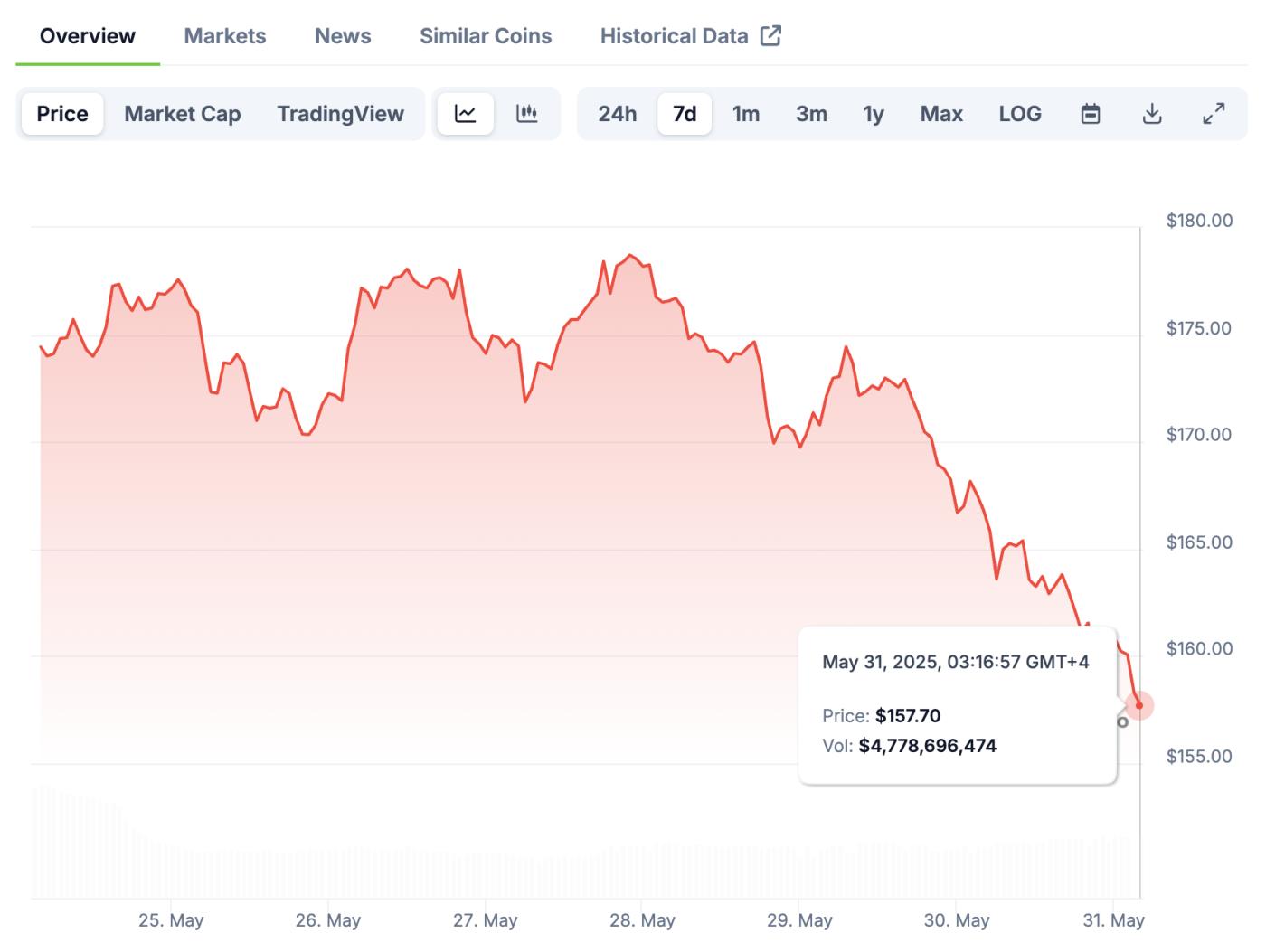Original | Odaily (@OdailyChina)
Author | jk

On May 30, due to Trump's claims of potential new tariff measures, the crypto market overall declined, with BTC briefly falling below $104,000, and mainstream cryptocurrencies generally dropping. Investor sentiment turned cautious, and the market lacked clear short-term upward catalysts.
Mainstream Cryptocurrencies Broadly Retreat
According to Coingecko data, BTC was priced at $104,028, down 1.7% in the past 24 hours, with a 7-day decline expanding to 3.8%, and market cap falling to $2.07 trillion. Despite maintaining a high trading volume of $39.3 billion, the price trend remains under pressure. ETH's decline was more significant, dropping 4% within 24 hours, currently priced at $2,520, with market cap reduced to $306.8 billion.

Solana's decline was concentrated in the past two days, source: Coingecko
SOL became the mainstream asset with the largest pullback, falling 5.4% in 24 hours and 10.7% for the week, currently at $157, breaking below the $160 mark. BNB was relatively resilient but still recorded a 2.5% daily decline, currently at $662. XRP was priced at $2.16, down 4.7% in 24 hours and 7.3% for the week.
Dogecoin (DOGE) was one of the weakest currencies in this pullback, dropping 9.8% intraday and 15.1% for the week, currently at $0.1961. Despite ongoing community enthusiasm, signs of capital outflow are evident. In the absence of significant positive news or fundamental support, the crypto market faces short-term correction pressure. Currently, funds tend to seek safety, moving more towards stablecoins or temporarily staying on the sidelines.
Reason Analysis: Tariff Policy Fluctuations Trigger Risk-Averse Sentiment, Market Faces Short-Term Pressure
Recently, the Trump administration has implemented numerous tariff measures, here's a timeline summary:
May 29:
The US International Trade Court ruled that most of the Trump administration's global tariff policies are illegal, stating that the International Emergency Economic Powers Act (IEEPA) did not authorize the president to impose tariffs on almost all imported goods. The court emphasized that trade policy should be led by Congress, not unilaterally decided by the president. The White House immediately filed an appeal, accusing judicial intervention of hindering its economic diplomatic strategy, significantly increasing trade policy uncertainty.
May 30:
The Federal Appeals Court urgently ruled to temporarily suspend the lower court's decision, allowing the Trump administration to continue implementing tariffs during the litigation. (Although most tariffs were already suspended under agreements) This reversal intensified market concerns about policy volatility and implementation, with signs of capital outflow towards stablecoins and US dollar assets. The White House spokesperson publicly stated that court intervention is undermining US trade negotiation leverage and criticized judges for "excessive overreach".
Subsequently, the direct cause of this market decline was Trump's post on Truth Social, accusing China of "seriously violating" the mineral tariff-free agreement reached in Geneva mid-month. He stated that he had temporarily conceded to avoid worsening the situation with China, "pausing up to 145% punitive tariffs" but would consider re-applying pressure. This statement again released trade tension signals, with the market worried about escalating US-China conflicts. Amid rising risk-averse sentiment, the crypto market became a primary direction for capital withdrawal, with mainstream cryptocurrencies broadly declining.
Trump's Negotiation Style? Or Are Tariff Wars Really Coming?
Trump's negotiation style has consistently been characterized by "extreme pressure" and "strategic reversal", using high-profile threats and creating uncertainty to gain negotiation advantages. This strategy has been frequently seen in his trade negotiations with China and Europe.
Previously, similar strategies appeared in US-EU trade relations. After most tariffs had settled, Trump threatened to impose 50% tariffs on EU goods from June 1, then postponed the implementation date to July 9 after speaking with EU Commission President von der Leyen. The EU welcomed this and expressed willingness to accelerate negotiation processes.
This "high pressure - relaxation - re-pressuring" cycle has created a market impression of "Trump Always Chickens Out" (TACO), meaning he often retreats after applying pressure. Although Trump strongly opposes this, claiming his strategy aims to gain greater negotiation advantages, the market remains skeptical.
Based on past experience, despite current US-China trade tensions escalating, the market generally expects both sides might ultimately reach a new agreement through negotiations, avoiding further escalation. Therefore, while the market may experience short-term volatility, long-term expectations do not anticipate severe trade conflicts.







